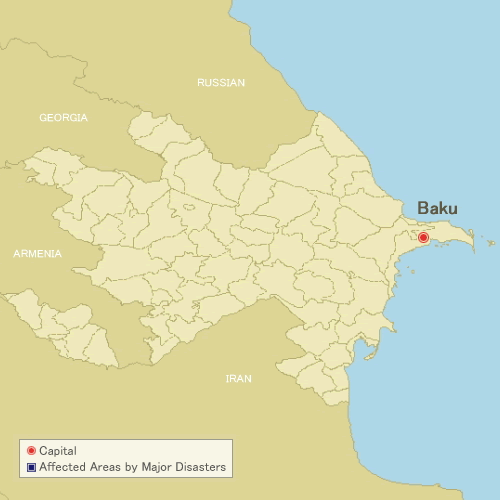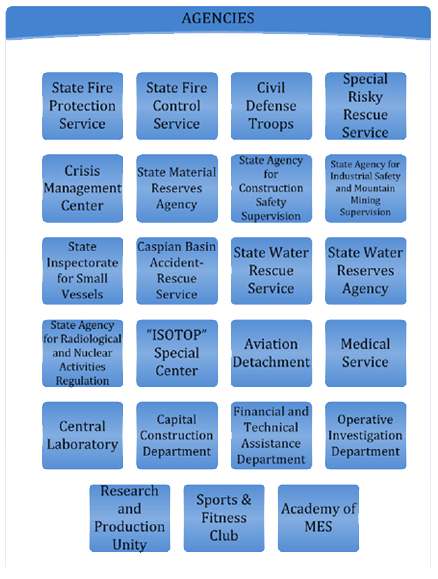TOP PAGE > Information on Disaster Risk Reduction of the Member Countries
Information on Disaster Risk Reduction of the Member Countries
 Azerbaijan
Azerbaijan
General Information
 Formal name: The Republic of Azerbaijan
Formal name: The Republic of AzerbaijanAzerbaijan is located between the continents of Europe and Asia, in the southeast of the Caucasus region and the western shores of the Caspian Sea.It has borders with Russia, Georgia, Armenia, Türkiye and Iran. Total area of the country is 86,600 square km. Capital city is Baku, situated on the shore of the Caspian Sea, in the south of the Absheron peninsula. It covers an area of 2,200 square km and has a population of approximately 5 million. Official language is Azerbaijani.
Population is 10.44 million which consists of 93-99% of Islam. (as of 2024)
Overview of Disasters
Azerbaijan is prone to flood, landslide, earthquake, drought.
Recent Major Disasters
Landslide (March 2000)
On 7 March 2000, a major landslide involving an area of 15 ha occurred in the Bayil zone of the Sabayil district, south of Baku city center. The landslide in the Bayil slope destroyed dozens of shops, apartments and gas stations. After the incident, it was decided to move roughly 300 families from this territory.
Earthquake (May 2012)
An earthquake measuring 5.6 on Richter scale struck Zaqatala and Gakh, north-western part of Azerbaijan, at 09:40 local time on 7 May 2012. 10 hours later an almost similar earthquake or aftershock hit the area again. Fifteen people from Zaqatala were injured due to these earthquakes. In addition, 3,124 houses and public buildings were either destroyed or damaged due to the earthquakes. Following this earthquake strong and regular aftershocks were again registered in both regions. In Zagatala, more than 6,500 houses and public objects suffered from the earthquakes and 6,949 families were evacuated and settled either in tents or nearby houses.
Flood (May 2010)
In May 2010 unusually large amounts of rain in the south of Azerbaijan caused the Kura River to rise to its highest level in over 100 years, bursting dams and overflowing onto nearby villages. This unprecedented level of flooding hit hardest in the Sabirabad, Imishli, Saatli districts, which is near the confluence of the Kura and Araz rivers. More than 24,000 people were affected with tens of thousands of homes flooded or destroyed and 50,000 hectares of farmland inundated.
Disaster Management System
Legal System
Established by the Decree of the President of the Republic of Azerbaijan, in 16 December 2005, Ministry of Emergency Situations (MES) of the Republic of Azerbaijan is the central executive body of the government, which is responsible for emergency management within the entire territory of the country. According to the decree “for the purpose of providing prevention of natural and man-made disasters and fires, elimination of their consequences, management of activities of the relevant bodies responsible for rescue and rehabilitation works by one centralized system, organization and realization of civil defense work in the country, the Ministry of Emergency Situations of the Republic of Azerbaijan is established.”
Organization
 Main activities of the Ministry of Emergency Situations (MES) are as follows.
Main activities of the Ministry of Emergency Situations (MES) are as follows.■ Protection of population and territories from fires and disasters.
■ Prevention of emergency situations and elimination of their consequences.
■ Ensuring of safety rules of water basins, building sites, industrial and mining enterprises and safe movement of small vessels in state waters.
■ Establishment and proper management of the State Resource Fund.
■ Organization of the protection of strategic objects exposed to natural, man-made and terror threats, neutralization of radioactive wastes.
■ Organization of quick response to emergency situations and management of humanitarian aids.
■ Organization and implementation of rescue-searching and first aid, aviation and other transport life-saving operations in case of emergencies.
■ Organization of awareness-raising activities among population regarding life safety rules and measures, methodical guidance over respective work done in this field by state bodies and public organizations etc.
Country Report
Country Report 2023 (English Version, PDF file)Country Report 2014 (English Version, PDF file)
Country Report 2011 (English Version, PDF file)

